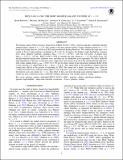IDCS J1426.5+3508: THE MOST MASSIVE GALAXY CLUSTER AT z > 1.5
Author(s)
Brodwin, Mark; Gonzalez, Anthony H.; Stanford, S. A.; Eisenhardt, Peter R.; Stern, Daniel; Zeimann, Gregory R.; McDonald, Michael A.; ... Show more Show less
DownloadBrodwin-2016-IDCS J1426.5+3508_ T.pdf (1.288Mb)
PUBLISHER_POLICY
Publisher Policy
Article is made available in accordance with the publisher's policy and may be subject to US copyright law. Please refer to the publisher's site for terms of use.
Terms of use
Metadata
Show full item recordAbstract
We present a deep (100 ks) Chandra observation of IDCS J1426.5+3508, a spectroscopically confirmed, infrared-selected galaxy cluster at z = 1.75. This cluster is the most massive galaxy cluster currently known at z > 1.5, based on existing Sunyaev–Zel'dovich (SZ) and gravitational lensing detections. We confirm this high mass via a variety of X-ray scaling relations, including T[subscript X]–M, f[subscript g]–M, Y[subscript X]–M, and L[subscript X]–M, finding a tight distribution of masses from these different methods, spanning M[subscript 500] = 2.3–3.3 × 10[superscript 14]M[subscript ⊙], with the low-scatter Y[subscript X]-based mass M[subscript 500,Y[subscript X]] = 2.6[+1.5 over -0.5] x 10[superscript 14] M[subscript ⊙]. IDCS J1426.5+3508 is currently the only cluster at z > 1.5 for which X-ray, SZ, and gravitational lensing mass estimates exist, and these are in remarkably good agreement. We find a relatively tight distribution of the gas-to-total mass ratio, employing total masses from all of the aforementioned indicators, with values ranging from f[subscript gas,500] = 0.087–0.12. We do not detect metals in the intracluster medium (ICM) of this system, placing a 2σ upper limit of Z(r < R[subscript 500]) < 0.18 Z[subscript ⊙]. This upper limit on the metallicity suggests that this system may still be in the process of enriching its ICM. The cluster has a dense, low-entropy core, offset by ~30 kpc from the X-ray centroid, which makes it one of the few "cool core" clusters discovered at z > 1, and the first known cool core cluster at z > 1.2. The offset of this core from the large-scale centroid suggests that this cluster has had a relatively recent ([< over ~]500 Myr) merger/interaction with another massive system.
Date issued
2016-01Department
Massachusetts Institute of Technology. Department of Physics; MIT Kavli Institute for Astrophysics and Space ResearchJournal
The Astrophysical Journal
Publisher
IOP Publishing
Citation
Brodwin, Mark, Michael McDonald, Anthony H. Gonzalez, S. A. Stanford, Peter R. Eisenhardt, Daniel Stern, and Gregory R. Zeimann. “ IDCS J1426.5+3508: THE MOST MASSIVE GALAXY CLUSTER AT z > 1.5 .” The Astrophysical Journal 817, no. 2 (January 27, 2016): 122. © 2016 The American Astronomical Society
Version: Final published version
ISSN
1538-4357
0004-637X